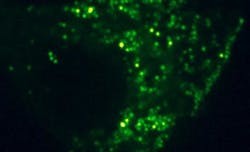New approach to particle-tracking algorithms increases precision
| The motion of insulin-containing vesicles, which contain thousands of insulin molecules within an insulin-secreting cell, was studied via particle-tracking software. This work stimulated collaborative research that led to the development of the single-pixel interior filling function (SPIFF) by scientists at the University of Chicago. (Courtesy of Norbert Scherer) |
In many scientific pursuits ranging from microscopy to astronomy, software is used to track the positions of small objects spread throughout an image field. Scientists at the University of Chicago (Chicago, IL) have now developed a more accurate method for analyzing such image data.1
Correcting systemic errors in analysis
The new software approach, called the single-pixel interior filling function (SPIFF), provides a mechanism to detect and correct systematic errors in data and image analysis used in many areas of science and engineering.
Currently, particle-tracking software allows researchers to determine the position of an object down to a single pixel and even explore subpixel localization to better than one-tenth of a pixel accuracy. With, for example, an optical microscope’s resolution of about 250 nm and an effective pixel size of about 80 nm, particle tracking allows researchers to locate the center or location of an object to within a few nanometers, provided enough photons are measured.
But subpixel-resolution algorithms often produce errors of precision and accuracy due to factors such as nearby or overlapping objects in the image and background noise.
SPIFF can correct the errors with little added computational costs, according to co-principal investigator Norbert Scherer, a University of Chicago chemistry professor.
Better than the normal precision limit
In the technique, statistical information is gathered and aggregated from many single-particle images over time or across an ensemble to produce more-accurate particle localizations; according to the researchers, the technique can sometimes do better than the so-called "unbiased Cramér-Rao lower bound," which is normally the highest precision that particle-tracking algorithms can achieve.
The researcher applied SPIFF to experimental data on colloidal spheres suspended in a liquid, and have since applied their method to many other data sets, including nanoscale features of cells (for example, vesicles), metallic nanoparticles, and even single molecules, Scherer says, adding that the SPIFF method is applicable to all tracking algorithms.
"We believe that SPIFF will be important for many studies in biology and nanoscience and, although we have not worked with images from telescopes, SPIFF could even help determine and correct errors in star-tracking data," he says.
Source: https://news.uchicago.edu/article/2017/02/03/new-method-improves-accuracy-imaging-systems
REFERENCE:
1. Stanislav Burov et al., Proceedings of the National Academy of Sciences, Dec. 26, 2016; doi: 10.1073/pnas.1619104114
